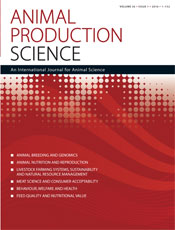
Animal Production Science
Volume 56 Number 1 2016
AN14777Fabric and greasy wool handle, their importance to the Australian wool industry: a review
Greasy wool handle is assessed on-farm as a means to improve fibre quality. This review looks at the different assessment protocols utilised by industry and notes the variable results obtained using different assessment protocols. Standardising an approach will result in a greater response to selection.
AN14444Effect of fitting sheep covers and injection of a mineral supplement on the brightness, clean colour and photostability of wool grown by grazing Merino sheep
The brightness, clean colour and photostability of Australian Merino wool is not currently suitable for white and pastel shade products without bleaching during processing. This study investigated whether coating fleeces and provision of a long-acting injection mineral supplement would improve these traits. Brightness and clean colour were both significantly improved by coating but there was no impact on photostability and no evidence of any improvement in the three traits due to the mineral supplement.
AN14474A regional model of sheep lice management practices for predicting the impact of treatment for lice when no lice are detected
A model of lice prevalence was used to examine the value of treating sheep for lice after shearing, when no lice have been detected. The model showed treatment was cost-effective when the risk that the flock was infested was more than 10%. We concluded that use of this intervention threshold would reduce the current prevalence of lice in Australian sheep flocks without increasing costs associated with managing lice.
AN14426Effects of long wool insecticide treatments on lice numbers and wool damage on sheep
Long wool treatments are frequently applied to control sheep lice between shearings, but no data was available to indicate the production benefits of these treatments in merino sheep. Both long wool treatments tested, one applied by hand jetting and one as a backline spray-on treatment, gave large reductions in louse numbers, significant increases in clean wool cut and significant improvement in a number of wool quality parameters.
AN13555Carcass and meat quality of organic lambs compared with lambs reared under traditional and intensive production systems
Possible health risks related to chemical, antibiotic and hormone residues in foods caused an increase in the demand for organic foods. Carcass and meat quality of lambs reared under organic, intensive and traditional systems were investigated to obtain information that can be a guide for production system preference for sheep farmers and meat product choice for consumers. Meat from traditional systems was found more acceptable while meats of organic and traditional systems were healthier according to meat fatty acid composition.
AN14017Effect of creatine monohydrate supplementation on carcass traits, meat quality and postmortem energy metabolism of finishing pigs
Supplementation with creatine monohydrate (CMH) before slaughter was beneficial to improving pork quality. In this study, we evaluated the effects of dietary supplementation with CMH in pigs on the meat quality and postmortem energy metabolism, and found that CMH supplementation could delay early pH decline and decrease the rate of glycolysis in postmortem longissimus dorsi muscle resulting in a decreased drip loss. These data provide convincing evidence for the widespread use of CMH supplementation to improve pork quality.
AN14183The effect of slaughter weight on the carcass characteristics of pork with sex type as co-variable
Increased pig slaughter weight has advantages for producers, processors and consumers. This study showed that increased slaughter weight improved carcass characteristics. These results indicate that heavier slaughter weights will be beneficial for producers and processors and should impact on production efficiency per se.
AN14066Environmental variation and breed sensitivity for growth rate and backfat depth in pigs
Selecting genotypes best suited for specific environments will benefit performance across environments when genotypes of animals respond differently to the changes in environments. The variation in environmental conditions was quantified based on mean growth rate and backfat depth of groups of pigs. Significant breed-by-environment interactions were found for growth rate but not for backfat depth. Large White, the leaner breed, was less able to perform consistently across the observed range of environmental conditions while Duroc was least sensitive.
AN14622Evaluating vitamin D with graded levels of strontium supplementation on broiler chicken performance and mineral composition
Vitamin D and strontium (an element similar to calcium) have a close physiological relationship and have been shown to improve broiler chicken performance and human skeletal integrity. Vitamin D and strontium were shown to have a significant interaction on bird performance. Higher levels of vitamin D improved bodyweight gain and helped reduce poor growth and feed efficiency caused by feeding strontium at the highest level of 0.12%. Calcium and sodium were found to be present in bone at an approximate ratio of 30 : 1. Further research is required to evaluate optimum dose rates for strontium and vitamin D supplementation.
AN13442Descriptive statistics and the pattern of horse racing in New Zealand. 1. Thoroughbred racing
It is important to understand the ‘normal’ pattern of Thoroughbred racing in New Zealand in order to identify industry trends and changes. Over the past 7 years Thoroughbred racing has remained relatively consistent in terms of races, starts, and horses involved in racing. These results provide background for future studies of Thoroughbred racing in New Zealand.
AN13443Descriptive statistics and the pattern of horse racing in New Zealand. 2. Harness racing
It is important to understand the ‘normal’ pattern of Harness racing in New Zealand in order to identify industry trends and changes over time. This study describes the pattern of pacing and trotting races in Standardbred racing and highlights factors unique to the Harness racing industry. Differences in track surfaces, gait, region and drivers between the Standardbred and Thoroughbred industry suggest a need for baseline data specific to the Harness racing industry in New Zealand.
AN14560Genetic variation within and between subpopulations of the Australian Merino breed
Genetic differences between strain and flock subpopulations of the Australian Merino were compared to differences within subpopulations. For most traits, the differences between subpopulations were at least as large as the differences within subpopulations. The relative variances estimated from this study can be used to improve breeding value estimation models, and by breeders to increase genetic gain.
AN14666Ability of sire breeding values to predict progeny bodyweight, fat and muscle using various transformations across environments in terminal sire sheep breeds
How do we accurately evaluate the genetic merit of terminal sires bred across the wide range of Australian sheep environments? When their weights and fat measurements were transformed to a proportion of the mean of their contemporary group (% or units) it resulted in consistent relationships between the estimated genetic merit of sires and the performance of their progeny. These data transformations methods have now been implemented in the national genetic evaluation system to allow the breeding values of terminal sires to be more accurately compared across Australia.
AN14612Genetic variability detected at the lactoferrin locus (LTF) in the Italian Mediterranean river buffalo
Eleven polymorphisms were detected for the first time between exons 15 and 16 of the Mediterranean river buffalo lactoferrin gene. The exonic markers g.88G>A and g.1351G>A were selectively neutral in relation to the improvement of milk production because no association with milk yield was revealed. However, they be used for future association studies with other traits of economic interest.
AN14550Correlations of methane and carbon dioxide concentrations from feedlot cattle as a predictor of methane emissions
Methane emissions from livestock industries contributed 70% of total agricultural greenhouse gas emissions in Australia in 2009. It is difficult to measure methane emissions from large commercial feedlots. Accurate measurements are required. A 2-year study conducted at two Australian commercial feedlots showed a strong correlation between methane and carbon dioxide concentrations. This result could be used as a new method to predict methane emissions for the purpose of inventory, mitigation strategies and animal feed efficiency at Australian beef production systems.
AN13370Estimates of repeatability and heritability of methane production in sheep using portable accumulation chambers
We have developed a new method for measuring enteric methane production – that allows the prediction of methane production of large numbers of individual animals under field conditions. This will facilitate estimates of genetic parameters and help identify individuals whose rumen physiology and microbial ecology can be studied to improve our understanding of the biological bases for differences in methane production. Our work also suggests that more than one measure is desirable and that measurement of feed intake is critical.
AN14636Supplementation for beef cattle on Marandu grass pastures with different herbage allowances
The efficiency of the supplementation for beef cattle is dependent on forage allowance. The performance of beef cattle with supplemented or without at three herbage allowances was evaluated. The supplements increased bodyweight gains without compromising the gain per hectare at different herbage allowances.
AN14019Legume grain-based supplements in dairy sheep diet: effects on milk yield, composition and fatty acid profile
Supplements based on GMO-free legume grains (chickpea, faba bean, or pea) are proposed as alternatives of a concentrate feed containing soybean in dairy sheep feeding. The faba bean and pea had no adverse effects on milk production, whereas chickpea reduced milk yield, showed a lower efficiency of protein utilisation for casein synthesis, but increased the content of some healthy polyunsaturated fatty acids. The legume grains can replace soybean as components of the concentrate feed for lactating ewes.
AN14007Relationship between the concentration of bone morphogenetic protein-15 (BMP-15) and growth differentiation factor-9 (GDF-9) in pre-ovulatory follicles, ovarian cysts and serum in sows
In sows, ovarian cysts constitute a significant proportion of ovarian dysfunction and are a serious problem disturbing fertility in pigs. Therefore, studies contributing to more fully explain the pathogenesis of porcine ovarian cysts are very important. Our studies suggest that BMP-15 and GDF-9, which belong to transforming growth factor β (TGF-β), may play a role in the mechanism of the formation of ovarian cysts, and to determine their concentrations in serum may be useful in the diagnosis of ovarian cysts in sows in the future.
AN14111Egg quality and production performance of laying hens injected with growth hormone and testosterone in the late phase of production
Hen ageing is accompanied by a disruption of productive performance, namely egg production. The aim of the present study is to clarify the intricate network of reproductive physiology in laying hens in the late phase of reproduction by means of exogenous growth hormone and testosterone injection. The results show the positive effects of the exogenous hormones on egg quality and production performance.



